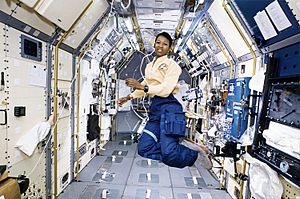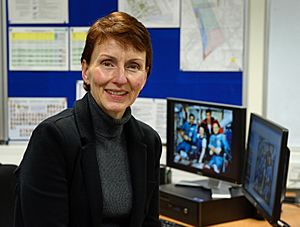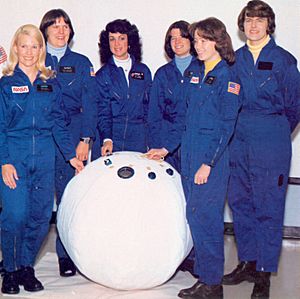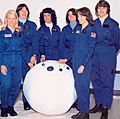Women in space facts for kids
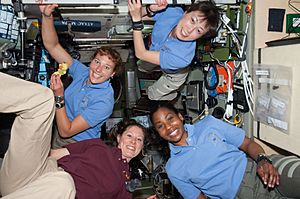
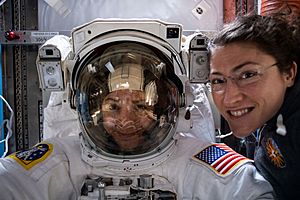
Women have been an important part of human spaceflight since it began. Many women from different countries have worked in space. However, fewer women are chosen to go to space than men. By 2020, only about 10% of all astronauts who have traveled to space were women.
The very first woman to go into space was Valentina Tereshkova. She was from the Soviet Union and flew in 1963. By October 2021, most of the 70 women who have been to space were from the United States. They flew on the Space Shuttle and to the International Space Station. Other countries have also sent women to space, like Canada, Japan, Russia, and China.
Women face many of the same challenges in space as men. These include physical and mental difficulties. Studies show that short space missions usually do not harm women. Some research even suggests that women might be better for longer space missions. However, studies have also shown that unfair treatment has been a big problem for women wanting to go to space.
Contents
Women in Space Programs
Early Days of Space Travel
Human spaceflight started in the late 1950s and early 1960s. Early studies looked at how space would affect humans, including women. These studies actually suggested that women might be well-suited for space travel.
During the "Space Race" between the Soviet Union (USSR) and the United States, both countries first chose space pilots from their military. These pilots were all men.
The first woman to fly to space was Valentina Tereshkova. She flew aboard Vostok 6 on June 16, 1963. Her flight lasted 70.8 hours, and she orbited Earth 48 times. The USSR did not send another woman into space until 1982. That's when Svetlana Savitskaya became the second woman in space. The first American woman, Sally Ride, went to space in 1983.
After Sally Ride's mission, many more women have flown in space. Still, women make up only about 10% of all people who have gone to space. They are still chosen less often. So far, only men have walked on the Moon. The US Artemis program hopes to send the first woman to the Moon.
Soviet Union (USSR)
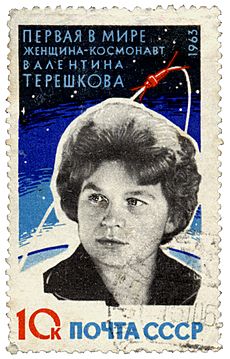
In 1961, a Soviet space program leader, Nikolai Kamanin, pushed for women to become cosmonauts. He was inspired by questions from the press. He got support from the main space program leader, Sergey Korolev. Kamanin wanted to make sure a Soviet woman flew to space before an American woman. To do this, the women cosmonauts started their training before the men.
Valentina Tereshkova was the only one of five women chosen to fly. She went into space on Vostok 6 in June 1963. Her backup was Irina Solovyova. Soviet Premier Nikita Khrushchev was happy with Tereshkova's choice because her father was a collective farm worker. This was good for propaganda. Five months after her flight, Tereshkova married another cosmonaut, Andriyan Nikolayev. Their daughter, Elena, was the first person whose mother and father had both traveled into space.
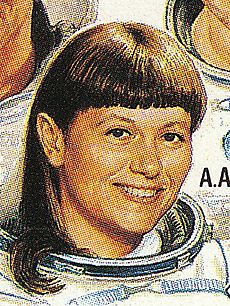
In 1980, the USSR started training women cosmonauts again. In 1982, Svetlana Savitskaya became the world's second woman in space. She flew on the Soyuz T-7. She was also the first woman to fly to space twice. On July 25, 1984, she became the first woman to walk in space (do an extravehicular activity, or EVA) outside the Salyut 7 space station.
The third and last woman launched by the USSR was Helen Sharman in 1991. She was the first woman from Western Europe. She was also the first woman to visit the space station Mir. Sharman was the first and only woman from the United Kingdom to go to space. She was not sent by the UK government but by a private project called Project Juno.
United States
In 1959, a group of thirteen female US pilots, called the "Mercury 13", wanted to become astronauts. They took the same medical tests as the men and often did just as well or better. This was not a government program. The idea of female astronauts faced a lot of resistance in the US government and NASA. These women never got the chance to become astronauts.
By 1976, NASA decided that its next group of astronauts, NASA Astronaut Group 8, would include women and minorities. Actress Nichelle Nichols, who played Uhura in Star Trek, helped NASA find candidates for this group. She successfully recruited the first women and people of color into the US space program. One of these recruits was Sally Ride. In 1983, she became the first US woman to fly in space. She was the third woman overall to fly in space. Since then, more than 50 American women have gone to space. Most of them flew on the Space Shuttle missions from 1983 to 2011.
Judith Resnik was the second American woman in space. She was the fourth woman overall. She flew on the first flight of the Space Shuttle Discovery in 1984. She sadly died less than two years later when the Space Shuttle Challenger was destroyed.
The first US woman to do a spacewalk (EVA) was Kathryn D. Sullivan in 1984. Mae Jemison became the first woman of color in space in 1992. Eileen Collins was the first woman to pilot the Space Shuttle in 1995. She later became the first female Shuttle commander. Susan Helms was the first woman on an International Space Station expedition crew in 2001.
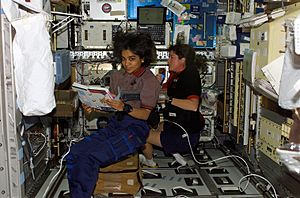
In 2007, Peggy Whitson became the first woman to command the International Space Station. On October 18, 2019, Jessica Meir and Christina Koch did the first spacewalk with only women.
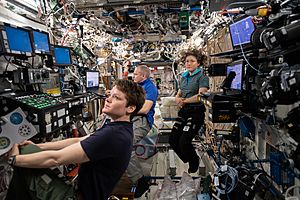
Only 12 humans, all men, have walked on the Moon. All these missions were part of the Apollo program between 1969 and 1972. No woman has ever walked on the Moon. In 2020, NASA announced plans to land astronauts on the Moon, possibly including women, as part of the Artemis program. Nine of the 18 candidates for the Artemis program are women. These include Nicole Aunapu Mann, Kayla Barron, Christina Koch, Kate Rubins, Stephanie Wilson, Jessica Meir, Jasmin Moghbeli, Anne McClain and Jessica Watkins.
Besides US citizens, US rockets have launched international astronauts. Roberta Bondar (Canada, 1992) and Julie Payette (Canada, 1999 and 2009) flew with the US space program. So did Chiaki Mukai (Japan, 1994 and 1998) and Naoko Yamazaki (Japan, 2010).
Russian Federation
The Russian Federation's space program, Roscosmos, took over from the Soviet program. So far, two women have flown with Roscosmos. Yelena Kondakova became the first woman cosmonaut for the Russian Federation in 1994. She was also the first woman to travel on both the Soyuz program and the Space Shuttle. Twenty years later, Yelena Serova became the second Russian woman cosmonaut. She visited the International Space Station on September 26, 2014.
Russia's only current woman cosmonaut, Anna Kikina, joined the corps in 2012. In 2019, Roscosmos announced changes to their space suits to fit women. In 2020, Kikina was chosen for a flight to the International Space Station in 2022.
The Russian space program has also hosted international cosmonauts. These include Claudie Haigneré from France (1996 and 2001), Anousheh Ansari from Iran (2006), Yi So-yeon of South Korea (2008), and Samantha Cristoforetti from Italy (2014).
Canada
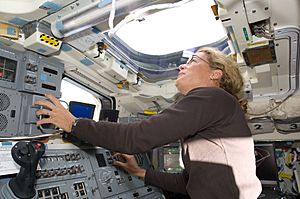
Roberta Bondar was the first Canadian woman in space. She flew on the Space Shuttle Discovery in January 1992.
Another Canadian woman astronaut is Julie Payette. She was part of the crew of STS-96 in 1999. On that mission, the crew docked the Shuttle to the International Space Station for the first time by hand. They also delivered supplies. In 2009, Payette flew on Endeavour for STS-127. She operated the Canadarm robotic arm. Payette later became the Governor General of Canada in 2017.
In 2017, Dr. Jennifer Sidey-Gibbons was chosen by the Canadian Space Agency for astronaut training. She became an official astronaut in January 2020.
Japan
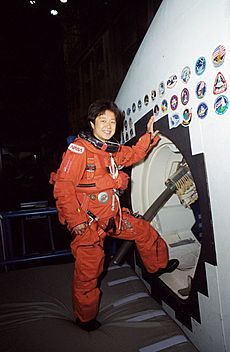
In 1985, Chiaki Mukai was chosen as a Japanese Payload Specialist candidate. She flew aboard STS-47 in 1992. Mukai has spent over 566 hours in space. She flew on STS-65 in 1994 and STS-95 in 1998. She is the first Japanese and Asian woman to fly in space. She is also the first Japanese citizen to fly twice.
Naoko Yamazaki became the second Japanese woman to fly into space. She launched on April 5, 2010, on the shuttle Discovery as part of mission STS-131. She returned to Earth on April 20, 2010. Yamazaki is an aerospace engineer. She was selected for astronaut training in 1999 and became certified in 2001. She was a mission specialist on her 2010 space shuttle flight and spent 362 hours in space.
European Space Agency (ESA)
The first Western European woman and British citizen to fly to space was Helen Sharman in 1991. However, she was not sent by a government space program. She was privately funded by Project Juno on a Soviet mission.
The first Western European and French woman sent by a state space agency was Claudie Haigneré in 1996. Since then, the only other woman sent by a European agency has been Samantha Cristoforetti in 2014. Cristoforetti is the first Italian woman to go to space.
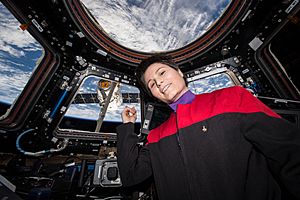
The 2022 European Space Agency Astronaut Group specifically invited women to join. For the first time, they also invited people with disabilities to apply.
China
In 2012, the Chinese space program sent their first woman to space.
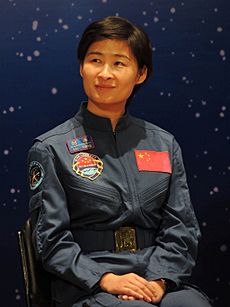
China's first female astronaut candidates were chosen in 2010 from fighter pilots. They were required to be married mothers. The Chinese government said that married women were "more physically and psychologically mature." They also thought that having children already would prevent spaceflight from harming their reproductive organs. However, the director of the China Astronaut Centre later said that marriage was a preference, not a strict rule. China's first woman astronaut, Liu Yang, was married but had no children when she flew in June 2012.
Wang Yaping became the second Chinese female astronaut. She was part of the Shenzhou 10 spaceship crew, which orbited Earth in June 2013. They docked with the Tiangong-1 orbiting space station.
Other Countries with Women in Space
- Yi So-yeon, South Korea (2008, funded by her country)
- Jessica Meir, Sweden (2019, has dual citizenship, flew as a US astronaut)
Women Space Tourists
After Helen Sharman, who was partly privately funded, Anousheh Ansari was the fourth person overall to pay for her own space travel. She was the first Iranian woman citizen (with dual US citizenship) to go to space. She was also the first privately funded woman to fly to the International Space Station. She flew to the station in 2006 on the Soyuz TMA-9 spacecraft.
Commercial Astronauts
In 2019, Beth Moses became the first woman to fly to space as a commercial astronaut (sub-orbital flight). Wally Funk, a member of the "Mercury 13" group, became the oldest woman in space when she flew on Blue Origin's New Shepard flight on July 20, 2021. She also broke the record for the oldest person in space at 82, though this record was later broken by William Shatner. On September 16, 2021, Sian Proctor and Hayley Arceneaux became the first female commercial astronauts to go into orbit on board Inspiration4.
Challenges for Women in Space
Space programs generally allowed women to join much later than men. NASA only opened its astronaut program to women in 1976. When Sally Ride became the first female US astronaut in 1983, reporters asked her unusual questions. They asked about her body and if she would cry if things went wrong.
Women with children have also faced questions about how they would balance their careers with being mothers. Shannon Lucid, one of the first US female astronauts, remembers reporters asking how her children would handle her being a mother in space. Women are often expected to be the main caregivers for children, which can affect their careers.
Physical Effects of Space on Women

Female astronauts experience the same general physical effects of space travel as men. These include changes due to weightlessness, like losing bone and muscle. There are also health risks from cosmic rays and dangers from the vacuum and extreme temperatures. Space travel can also cause mental stress.
Astronaut clothing was first designed for men. Since women started going to space, clothing like space suits and bras have been redesigned to fit women better. For example, there have been few small space suits made. This has sometimes made it harder for women astronauts to do spacewalks because they don't have suits that fit well.
Also, space toilet designs did not consider women until October 2020. That's when the first toilet with a better design for both women and men was sent to the ISS.
Radiation in Space
Both men and women are affected by radiation in space. Astronauts outside earth's magnetic field are exposed to radiation from the sun and from deep space. These high-energy particles are blocked by Earth's magnetic field. But they are a big health concern for astronauts traveling to the Moon or Mars.
Because of how risks are calculated for certain health issues, women at NASA can currently spend only half as much time on missions as men. This limits their career choices compared to men.
Astronauts on the International Space Station are exposed to about 0.4 mSv of radiation per day. A trip to Mars with current technology could expose astronauts to about 300 mSv. This is like having 24 CAT scans.
Pregnancy in Space
NASA has not allowed pregnant astronauts to fly in space. So, no pregnant women have been in space. However, scientists have done experiments on animals to learn about pregnancy in space.
For air travel, the United States' Federal Aviation Administration suggests a limit of 1 mSv total for a pregnancy. This is no more than 0.5 mSv per month.
Radiation can increase the risk of childhood cancers for a fetus. Also, children of female astronauts could become unable to have children themselves if the astronaut was exposed to too much radiation during the later stages of a pregnancy.
Scientists have studied how non-human mammals reproduce and grow in space. A Soviet experiment in 1983 showed that a pregnant rat gave birth to healthy babies in orbit. The babies were thinner and weaker at first but later caught up.
There is still much to learn about pregnancy in space for long-term missions.
After Birth
A 1998 Space Shuttle mission showed that rat mothers in space either did not produce enough milk or did not feed their babies. However, a later study on pregnant rats showed that they gave birth and produced milk normally.
No human children have been born in space. Also, no children have gone into space. But the idea of children in space is taken seriously. Some people have even discussed how to create school lessons for children in future space colonies.
People Behind the Scenes
Astronautics is the science of space travel. It has been made possible not just by women astronauts, but also by many women working in science and related fields.
Some important women who have contributed include:
- Eilene Galloway
- Laurel van der Wal
- Katherine Johnson
- Mary Jackson
- Dorothy Vaughan
- Nichelle Nichols
Other well-known women have also helped create interest in space programs. In the early 2000s, Lori Garver started the "AstroMom" project. She wanted to make commercial spaceflight more visible. She hoped to fill an unused Soyuz seat going to the International Space Station. She believed that "creating a spacefaring civilization was one of the most important things we could do in our lifetime.”
Images for kids


